ヴィンランドサガに窺える償いの道 Finding the Road to Atonement in the manga ''Vinland Saga''

好評の漫画である「ヴィンランドサガ」の新巻の発売をきっかけにシリーズについて改めて回想する機会としました。11世紀の頭の北欧が舞台となるこの漫画ですが、「償い」というテーマを中心に物語が展開していきます。主人公のトールフィンにとって償いの道を歩むのは苛烈な葛藤でもあります。このテーマを念頭に、この漫画の醍醐味が良く伝わる三つのシーンを選んで拙僧なりの英訳を付け加えて紹介したいと思います(注意:ネタばれ在り)。
The release of the latest installment in the acclaimed manga Vinland Saga has inspired me to go back and reflect on this series. Set in the early 11th century in Northern Europe, the story in this manga focuses on the theme of atonement. The road to atonement proves to be a vicious struggle for Thorfinn, the main protagonist of the series. There are three particular scenes that I feel wonderfully examine this theme and show how great this manga is. I have provided my own translation of the original Japanese below (WARNING: some spoilers)
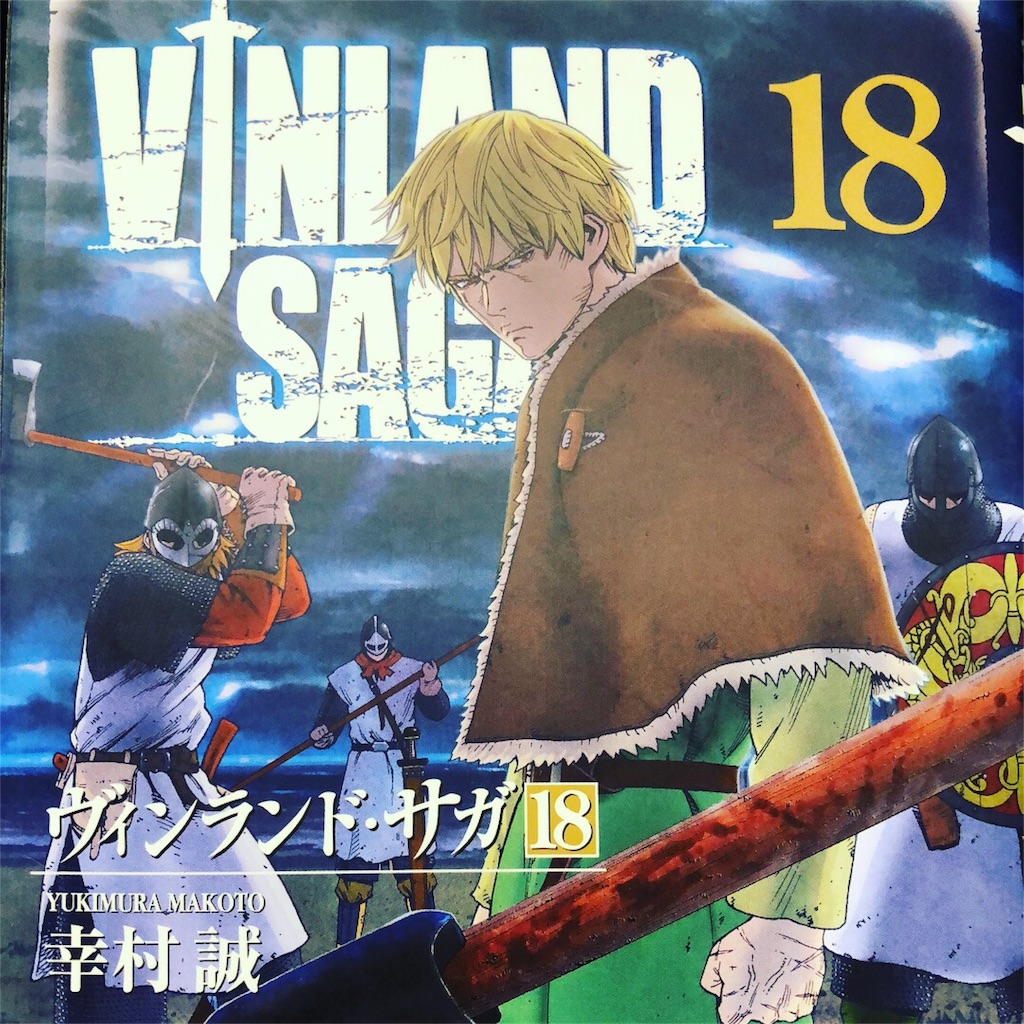
トールフィンのお父さんトールズはかつてヨーム戦士団の4人の大隊長の一人で、「ヨームの戦鬼(トロル)」と呼ばれた冷酷な戦士でした。ただし、戦場とその不毛を倦んで(あぐんで)、自分の戦死を装って家族を連れてアイスランドに逃げました。そこの新天地に根を植えて、「本当の戦士とは何か」の答えを模索しながら戦乱のないアイスランドで家庭を養い、平和に暮らしてきましたが、戦場で生きてきた彼の過去が生んだ因縁は遂に現れ、彼は再び戦場へ向かわざるを得なくなってしまいした。初めて自分の父の戦士の伝説的な功績を知って興奮するトールフィンが父の武器を手にするシーンは非常に印象的でした。そこでトールズがトールフィンに向けて言う言葉を通し て「本当の戦士は何か」と自分が辿り着いた答えを伝えようとします。(日本語はスクリーンショットにありますので、英訳のみの掲載となります。以下は同様です)。
Thorfinn's father is Thors, and he was once one of the four great generals of the Jomsviking army. He was known as the "Troll of Jom" for his ruthless cunning in battle. However, he grew weary of war and the utter futility of it all, and decided to flee to Iceland with his family, faking his own death. Laying roots in his new home, he lives in peace raising his family in a land without war, all the while searching for what it means to be a "true warrior." However, the bad karma from his life on the battlefield eventually rears its head, and once again he must head into the fray. Thorfinn is overwhelmed with excitement upon learning of the legendary exploits of his father, and there is a really impactful scene in which Thors finds him holding the weapons he used in the past. Speaking to his son, Thors attempts to convey the answer at which he arrived (English text below Japanese screenshots; manga screenshots read right to left).

Thors: Tell me, who do you intend to kill with those?
Thorfinn: My... enemies.
Thors: So who are your enemies?
Thorfinn: Ahh... Halfdan???
Thors: Listen Thorfinn... You have no enemies.
That's true for all people. No one has any real enemies.
There's nobody that deserves to be hurt... Not anywhere.
「不戦の誓い」を込めた父の篤い訴えの意味は子供のトールフィンにとって理解し難いものでありました。どうしても「ヨームの戦鬼」の戦いぶりを見たくて、その好奇心に駆り立てて次の日に出航した欧州大陸へ向かう父の船にこっそりと乗り込みます。しかしフェロー諸島でトールズを暗殺するため雇われた傭兵団の待ち伏せに遭い、父はその首領アシェラッドとの決闘で目のまえに殺されました。復讐の炎に包まれたトールフィンはその後アシェラッド兵団に取り付いて、父の仇を打てる日がくるのを待ちます。
Thors's fervent plea was essentially an oath to never to put anyone to his sword again, but it was too difficult for Thorfinn to understand. He was eager to see the "Troll of Jom" go berzerker on the battlefield, and this curiosity drives him to sneak on board his father's ship when it sets out for Europe the following day. However, they are ambushed in the Faroe Islands by a group of mercenaries hired to assassinate Thors. Thorfinn watches as his father is slain before his eyes in his duel with the Asherrad, the leader of the Viking mercenary troop. Thorfinn becomes consumed by a fiery vengeance and attaches himself to Asherrad's band, waiting for the day in which he can avenge his father's death.
アシェラッドは非常に興味深いキャラクターです。トルフィンには仇として命を狙われながらも、彼を手下として使いこなします。ある意味で父親のようにトールフィンの成長を見守って行きます。トールフィンにとってもアシェラッドが父親的な存在に成り、そして自分の父と同じように目の前に殺されてしまいます。死にかけているアシェラッドがトールフィンと最後に交わす会話は心に沁みるシーンです。トールズと同じように、復讐と殺し合いの連鎖で生きていくの不毛さを必死に訴えます。
Asherrad is a truly fascinating character. He takes Thorfinn in and has him work alongside his men, despite knowing that the boy seeks to kill him and avenge his father's death. In a certain respect, we see Asherrad watching over Thorfinn as he grows up much like a father would. The reverse is true for Thorfinn, with Asherrad becoming that fatherly presence in his life... only to be killed right before his very own eyes again. The scene depicting the final conversation between Thorfinn and a dying Asherrad is really touching. He attempts to convey the utter futility of a life of vengeance and ceaseless killing, much as Thors had done.

Thorfinn: Don't you go dying on me! I won't allow it!
Thorfinn: Get up! We have unfinished business to settle! You're mine to kill!
Asherrad: (To himself) This is why you've always been a handful Thorfinn.
Asherrad: (To Thorfinn) Tell me... What did you intend to do with your life after I'm gone?

Asherrad: Haha, you've never thought about that. Goes to show with you.
Thorfinn: Silence! That doesn't concern you...
Asherrad: Life's much more than this... Don't let this vengeful hate continue to hold you back...
Asherrad: Your path lies beyond the world your father found... Go forth, Son of Tors...
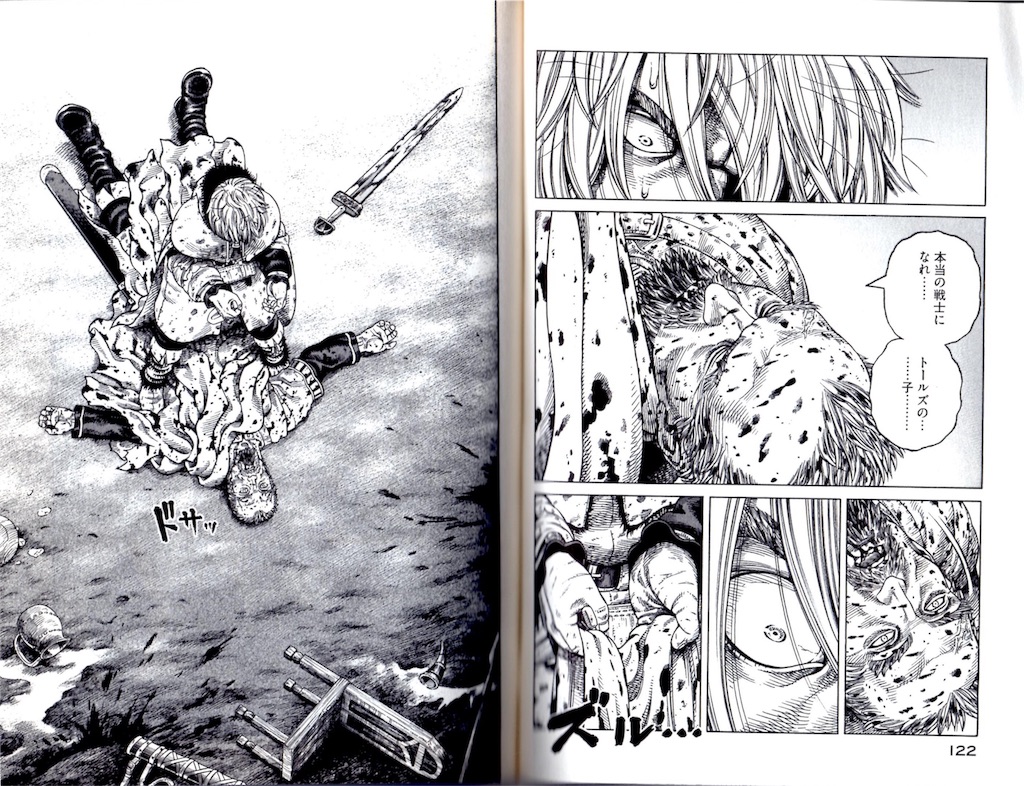
Asherrad: Go and become a true warrior... Son... of... Tors.
アシェラッドの死の後に奴隷身分に落とされ、デンマークのユトランド半島の広大な農場の主に買われ、その森林の開墾の仕事が命じられます。復讐という生きる目的を失い、二十歳頃になる無気力にただ生きていたが、ある日同じく奴隷としてかわれた元農民の青年とエイナルとの出会いによりトールフィンの人生が大きく変わります。共に開墾作業に取り組む生活の中で、エイナルが積極的にトールフィンにはなしをかけて、彼の心を少しずつ開いていきます。それまでの血に染まった人殺しの生き方しか知らなかったトールフィンがエイナルから農業を通して生命を育つ人の命を支える喜びを始めて知ることになります。ただし、彼に包まれている後悔の闇はまだ深く、毎晩に悪夢に苛まれまていました。その悪夢の中に彷徨うトールフィンが遂に暴力との決別を誓い、子供の頃に聞いたヴィンランドという遥か海の向こうの土地を目指し、そこへ世の中から迫害に苦しんだ人々を連れて「戦争も奴隷もない平和な国」を作ることを決意します。その新たな使命を見つけたことをエイナルに打ち明けるシーンはまた印象的です。トールフィンの過去に対する後悔と新な使命を果たしながら少しでうもその罪を償う決心がよく描写されていると思います。
Thorfinn falls into slavery after Asherrad's death and is bought by the owner of a vast farm on the Jutland peninsula in Denmark, where he is charged with clearing the forest for new fields. The next few years of his life Thorfinn simply goes through the motions, having lost the object of revenge that he had made his sole purpose for living. Around the time he turns 20 he meets Einar, a young slave from a family of farmers, and their encounter marks a major turning point in Thorfinn's life. Einar makes an active effort to talk to Thorfinn as they go about their work on the farm, and these conversations help Thorfinn to open up. Until then, he had only known a blood-soaked existence of taking life, but his experience on the farm with Einar shows him the joy of cultivating life that in turn supports the lives of others. However, he still finds himself enveloped by the deep and dark swells of regret, and is assailed by nightmares each and every night. Wandering through this darkness, Thorfinn pledges to completely forsake violence and dedicate his life to helping the oppressed. He aims to take them to Vinland, the land far across the ocean that he heard of as a child, and create a place free of war and slavery. The scene in which he shares this newfound mission with Einar really speaks to the heart. The author does a beautiful job portraying both the remorse Thorfinn feels for his past, and his determination to atone for his sins the best he can by fulfilling this mission.

Einar: But there's people like you Thorfinn. You reject what many consider to be normal and right. Is it that strange to swear not to hurt others?
Thorfinn: At least in Norse society... People label you a coward, and cowards get left out.
Einar: That's not right.
Thorfinn: I've accepted it. There's no helping it. But it's probably best that way if I'm going to carry their burden.
Einar: Who's burden?
Thorfinn: That of the dead.
Thorfinn: I'm visited every night by the souls of those I killed. They torment me. "Why did you kill me," they ask. "How could you kill all these people--fathers, brothers, and sons--knowing the anger and hate you felt when your own father was killed?"

Thorfinn: I have to make my penance with them... taking them to a place where they can rest in peace...
Thorfinn: But I can't take it any more. This burden is too much for me to bear alone.
Einar: Do these dead souls only appear to you? Are other warriors tormented by the spirits of those they killed?

Thorfinn: I can't speak for others. In my case, I began to see them after I became a slave. Maybe we can't see them while we're still warriors.
Einar: I see. I guess it's impossible to see them while people are still warriors.
Thorfinn: It's always on my mind... finding a way to earn their forgiveness.
Thorfinn: Laying down my sword doesn't seem to be enough... That's a given.
Thorfinn: Simply promising to never kill or destroy anything does not suffice as atonement.
Thorfinn: I need to grow more wheat than what I trampled under my feet.
Thorfinn: I need to fix more houses than I burned to the ground.
Thorfinn: I need to do what I can to weed out the death and destruction I sowed with the seeds of life and creation.
ものを破壊するのは容易いであり、それを建て直すのがそれ以上難しいことであります。この投稿の頭で書いた通り、「ヴィンランドサガ」は「償い」というテーマを真剣に吟味する漫画であり、それこの作品の醍醐味であると思います。「完全たる償いは本当に可能のか?」トールフィンの物語のこれからの展開を通してこの答が少しずつ見えてくると願うばかりでいます。
While it's easy to destroy things, building them back up is much harder. Just as I wrote above, Vinland Saga seriously examines the theme of atonement. The beauty of this manga, in my view, lies in its examination of this issue. "Is complete atonement truly possible?" I hope the answer to this compelling question slowly comes to light as Thorfinn's tale continues to unfold.
フォースは法力!?三毒の焔(ほのお)を消すために使われるもの Finding the Force within Buddhism: The Power to Extinguish the Fiery Triumvirate that Poisons the Soul

昨年の12月にエピソード8「最後のジェダイ」の公開に伴って、毎日新聞が「私とスター・ウォーズ」という興味深い特集を掲載しました。その記事で紹介された一人は禅僧の枡野俊明でした。この記事のおかげで枡野氏が著した「スターウォーズ:禅の教え」を知り、年末に購入し一か月ほどに渡り毎日の帰宅電車で少しずつを読み進みました。本書はタイトルの意味通りに、禅語を通してオリジナルトリロジーの名シーンを読み解いていきます。この斬新な視点からスターウォーズを読み直すことにより、多数の新な発見が見えてきました。印象に残った禅語はたくさんありましたが、「終わりに」で展開する僧侶の持論が本書に買う価値を十分与えるではないかと思います。その「終わりに」で書かれたメッセージは本書の醍醐味を見事に伝えているので、下記の通り抜粋し紹介したいと思います。
The Japanese newspaper Mainichi Shinbun ran a special feature last year in December when The Last Jedi was released in which they asked people from different professions to talk about their own connection with the saga. One of the people they interviewed for this article was the Zen priest Shunmei Masuno, and it was through this article that I discovered his book Zen Wisdom from Star Wars. I bought it at the end of the year and spent the next month reading a little of it every day on my train ride home. Just as the title implies, Masuno uses different Zen words to explain famous scenes from the original trilogy. It's a really fresh approach to Star Wars, and one that leads to many new discoveries. There were a number of words that really stuck with me, but the views Masuno conveys in the epilogue make this book one worth buying. This section conveys a great message that encapsulates the essence of the book, so I'd like to share this excerpt here for the reader's enjoyment.

「終わりに」(Epilogue)
「スターウォーズ」には、「フォースと共にあれ」というセリフがジェダイや同盟軍の合言葉のように、幾度となく登場します。「フォース」は他者の心を読み取ったり、操ったり、また敵の攻撃をかわしたり、直接に触れることなくものを動かすことができます。そして、「フォース」は、修行を積んだものだけ操れるものとして描かれます。これらを観て私は「フォース」は「法力」かも知れないと思いました。
The words “May the Force be with you” form the beloved phrase that is uttered countless times throughout the saga by the Jedi and later on members of the Rebel Alliance. Using the Force, individuals can read the minds of others, influence their actions, parry the attacks of an oncoming foe, and move objects without physically touching them. Star Wars shows us that only individuals who have trained diligently are truly capable of wielding the Force. In watching the saga, I can’t help but think that the Force may be a representation of the power of Buddhism.
法力とは、仏法を修行して得られた功徳[H2] の力。法力を使ったという伝説で有名なのは弘法大師空海(日本に真言宗を伝えた僧侶)です。弘法大師が杖をつくと泉が湧き井戸や池となった、といった伝承は今も日本各地に残っています。
The power I speak of is the “force” to do good deeds that is developed by putting Buddhist tenets into practice. There are famous legends of this power being used by Kuukai, the priest who brought esoteric Buddhism to Japan. Tales from regions all over the country speak of fresh springs and wells forming on the ground touched by Kuukai’s staff.
ヨーダは、ルークに対して「フォースとは何か?」と時折、説いていますが、エピソードVでは、「ジェダイの力はフォースから溢れてくる。じゃが、ダークサイドに用心しろ。怒り、恐怖、敵意、これらがフォースのダークサイドじゃ」と教えています。このダークサイドとは、禅で言えば「三毒」です。「三毒」とは、「貪り」、「怒り」、「愚かさ」のこと。ダースベイダーは三毒の象徴でもあるでしょう。
In Episode 5, we see Yoda teach Luke about the nature of the Force on a number of occasions. He tells Luke, “A Jedi’s strength flows through the Force. But beware of the Dark Side. Anger, fear, aggression; the dark side of the Force are they.” In Buddhism, these Dark Side elements are referred to as the “three kleshas that poison the soul”. They are “greed”, “anger”, and “ignorance.” I believe that Darth Vader can be taken as the personification of this triumvirate.

そのダースベイダーである父親を殺すか、ルーク自身がダークサイドに陥るか?ルークは対峙します。しかし、彼は、そのどちらの道を選びませんでした。殺すこともダークサイドに寝返ることもなかったのです。ルークは、父に「善いの心」が残っていることを信じ、欲に駆けられてダークサイドに入ることを選ばず、自分のライトセーバーを投げ捨てました。これは禅の解釈をすれば、父の中にある仏性を信じ、執着を捨て、ライトセーバーを喜捨したと言えます。このようなことを考えるとルークは、三毒の焔を消すために法力であるフォースを使ったのではないでしょうか。
In the original trilogy, Luke found himself faced with a decision: Does he kill his father, or does he give in to the Dark Side. He elected to do neither, refusing to embrace the call of the Dark Side or take the life of his father. He believed that a good heart still lay beneath the veneer of Darth Vader. Thus, he rejects the urges of greed that lead to the Dark Side and tosses aside his lightsaber. From a Zen Buddhist perspective, the act of throwing away his lightsaber can be expressed with the word 喜捨 (kisha, or literally “joyfully throw away/let go). Luke believes in the compassion that dwells within his father, and this motivates him to let go of his attachments by discarding his Jedi weapon. When viewed in this light, the argument could be made that Luke used the Force to rid himself of the three kleshas (poisons) that threatened to taint his soul.
「今」「ここ」にいる自分の本来の姿に出会うことが禅の基本
Discovering your true form in the “here” and “now”: The essence of Zen
「禅」では、過去も未来もなく、現在がすべてと考えます。本書の中でも紹介していますが、「而今(にこん)」という禅語がその考えを端的に表しています。今なすべきことに集中するというのは、禅の生き方そのものなのです。
The present is everything in Zen. There is no past or future. The Zen word “Nikon (而今)” introduced in this book is a straightforward expression of this concept, literally translating to “live in the moment”. That is what Zen is all about: focusing on what you need to do in this moment.

Source: Entre-Labo Corporation
ルークはたびたび、師であるヨーダやオビ=ワンから「今に集中せよ」と教えを受けます。その「而今」をルークが最初に意識したのは、きっとヤヴィンの戦いのときではないでしょうか?ルークはフォースと一体となったオビ=ワンからの声を耳にし、自動照準器を外して肉眼に頼らず、「今」に集中し、見事に初代デス・スターを破壊します。「而今」は、一瞬一瞬の積み重ねが一生をつくり上げていくことを教えてくれますが、まさにルークはこのとき、「今」の大切さを感じたのです。ルークは(将来の)共和国の平和を願い、ジェダイとしての道を歩み始めますが、当初は実現しそうもないように思えた共和国の平和という大きな目標も「而今」の教えに従い、「今」に集中した結果、光明がしてきます。
There are moments throughout the saga in which we see Yoda or Obi-Wan admonish Luke to concentrate on the ''now.'' I feel the first time Luke really became attuned to the meaning of “nikon” was during the Battle of Yavin. Luke hears the voice of Obi-Wan, who had become one with Force, and then turns off his targeting computer and chooses not to rely on his naked eyes, electing instead to focus on the moment. This moment of concentration enables him to blow the first Death Star to smithereens. The word “nikon" imparts an important lesson, teaching us that life is the steady accumulation of each passing moment. I feel in that moment in the Death Star trench was the first time that Luke truly understood how important the “now” is. From there he begins to long for peace in the future Republic and decides to take up the mantle of the Jedi. Such a grand vision seemed impossible to achieve when he sets out on his journey, but by drawing upon this “nikon” tenet and concentrating on the moment, light begins to shine on that end goal.
人は、何かを得てそれを持っていると、失うのが怖くなります。そして、また来てもいない未来を思い、起こりもしないことを心配してしまいがちです。またすでに過ぎてしまっているのに、過去に対して「ああすれば良かった。こうすれば良かった」と後悔しがちです。しかし、未来も過去も現在ではありません。命の真理は「今」にしかありません。ですから、今やれること、やるべきことを精一杯行う。そうすれば、いくつもの点が繋がって、やがて人生という線になります。
Human beings fear losing that which we gain and hold onto. We also cast our thoughts to a future that has not yet come, and fret about things that have yet to come to pass. At the same time, all too often we reflect back on things in the past, tinged with regret over perhaps what we should have done. We must remind ourselves that neither the past nor future are part of the “here and now.” The underlying tenet of life is the “now.” That’s why we need to give our all in what we are doing in this instant. This continuous effort connects the figurative dots of each instance to form the line we know as life.

黙想するクワイ・ガン・ジン (エピソード1より) Qui Gon Jinn meditates (From Episode 1)
心の在り方を極めていくのが「禅」です。「禅語」は、その修行を通して会得した心を言葉にしたもの。現代に生きる人々は、時間に追われて余裕を失い、豊かな時間と空間を過ごすことが出来にくいストレス社会にいます。であるからこそ、心を静かに整えることが大切です。本書を片手に、そのようなひと時を皆さんが持ってくださったら、こんなに嬉しいことはありません。
Zen is all about refining our mind and heart. The Zen words conveyed in this book are an expression of the understanding and mind we gain through the application of these tenets. We live in a society seemingly controlled by stress, always hounded by the clock and struggling to find ample time and space to enjoy what we have. That is why it is so important to take a moment to still our mind and soul. Nothing would please me more than knowing this book helps to create those moments for you.
枡野俊明
Shunmei Masuno
日本庭園と盆栽苑を巡るTraipsing around a Japanese Garden and Bonsai Exhibit

今週は休みを取って、日本庭園を見たい来日中のお馴染み友人を昭和記念公園 へ連れて行きました。拙僧は何回もそこへ訪れたこともありますが、公園の奥の方にある日本庭園まで足を運んだことはなかったので、拙僧は非常に楽しみにしていました。そこでは#盆栽苑 というところもあって、梅雨らしいの天候で誰もいなかったですが、そのしとしととした雨は敢えて憩いの効果もあって、すこぶる落ち着いた雰囲気を醸し出していました。また、樹の葉っぱに付着した雨の雫はその緑の度合い一層に鮮やかにして、まるでその色の光を放っていたようにも見えました。そこで働く庭師(らしい)方が #盆栽の基本、醍醐味、見方を詳しく説明して頂いたおかげで、今まで垣間見ることが出来なかった盆栽の小さい宇宙の中で繰り広げる偉大な世界観を堪能できました。
This week I had some time off to take lifelong friends from back home visiting Japan to Showa Kinen Park to see a Japanese garden, something they were eager to check out. I had visited that park many times before, but I had never ventured to the back to see the Japanese garden there, so I was also really excited to see it. They had a bonsai garden, and with the weather typical fare for the rainy season there was no one else there to enjoy it. The soft mist falling had a rather soothing effect, creating an extremely relaxing atmosphere. The drops of rain resting on the leaves of the trees made the hues of green even more vivid, as if they were giving off a green light of their own. We were approached by (what appeared to be) the gardener that worked there, and he provided us with an detailed explanation about the fundamental elements of #bonsai, their essence, and things to keep in mind when viewing them. Thanks to this great lesson, I was able to enjoy the worldview of the tiny universe that unfurls within each bonsai creation, something I was never able to do before.

盆栽は基本的にで三要素で成り立っています。(1) #根張り: 盆栽の根が四方八方に張り出して、安定感と力強さがあること。(2) #幹: 立ち上がりが素直で、上に行くほど自然に細かくなっていくこと。(3) #枝配り: 幹から出ている枝の太さや間隔がバランスよく配置されていること。これからの要素を兼ね備えたものが理想的とされています。盆栽の楽しみ方は人それぞれです。ある作品の一つは一人から見れば流れる滝に見える一方、また別の人から見れば上る煙や寄せる波にも見えます。何よりは、一つ一つの盆栽に大きいな自然の景色の広がりを感じることが盆栽の醍醐味であると言えます。
A bonsai creation is comprised of primarily three elements. (1) #Nehari: This refers to the roots spreading out in all directions from the base, creating a sense of both stability and strength. (2) #Miki: This describes the stem rising up unfettered, naturally growing smaller and more concise as it stretches higher. (3) #EdaKubari: This refers to the branches extending out from the main stem, with the varying thickness and space between them achieving a fine balance. The ideal bonsai tree features a combination of these three elements. The way in which each tree is viewed varies by person. In the eyes of one person, a bonsai tree can resemble a waterfall, while to another it resembles a plume of smoke rising or a wave lapping up on the shore. The most important thing is that each bonsai work delivers the essence of the art, which is simulating the grandeur of nature on a smaller scale.

数多くの作品の中から特に気に入ったものを挙げようとすると、幹の一部が白くなっている盆栽でしょう。樹齢300年の直幹という種類の一本の盆栽が非常に気になって、それは何故なのか最初わからなかったけど、庭師の説明を聞いてからその一本の盆栽の魅力とその作品に織り込めた演出がくっきり見えるようになりました。その白い部分は実は幹の枯れている部分であり、それを残すことで自然の厳しさを演出していると言われました。また、その枯れた幹の白色部分とと若々しい葉の緑色部分の美しい対照を際立たせ、「死」と「生」が表裏一体であることを表せ、栄枯盛衰その意味も体現しています。この諸行無常は日本の審美であります。
If I had to pick which type of bonsai I liked out of all the works on display, the pieces that really caught my eye were ones in which part of the stem was white. There was one piece of the "chokkan (straight stem)" variety that I liked a lot, and that tree was around 300 years old. At first I couldn't quite place why I liked that particular piece, but after listening to the gardener's explanation I was able to see the charm of this tree and form of expression imbued within it. According to the gardener, the white portion is actually the withered part of the trunk, and by leaving it within the piece the artist was able to convey the stark and severe face of nature. At the same time, the white portion of the trunk and the green of the fresh young leaves create a beautiful contrast, reminding us that "death" and "life" are inseparable. In short, this tree symbolizes the ebb and flow of life. That transience is the essence of the Japanese aesthetic.

印象派に窺える般若心経 Buddhist Undertones to Impressionism
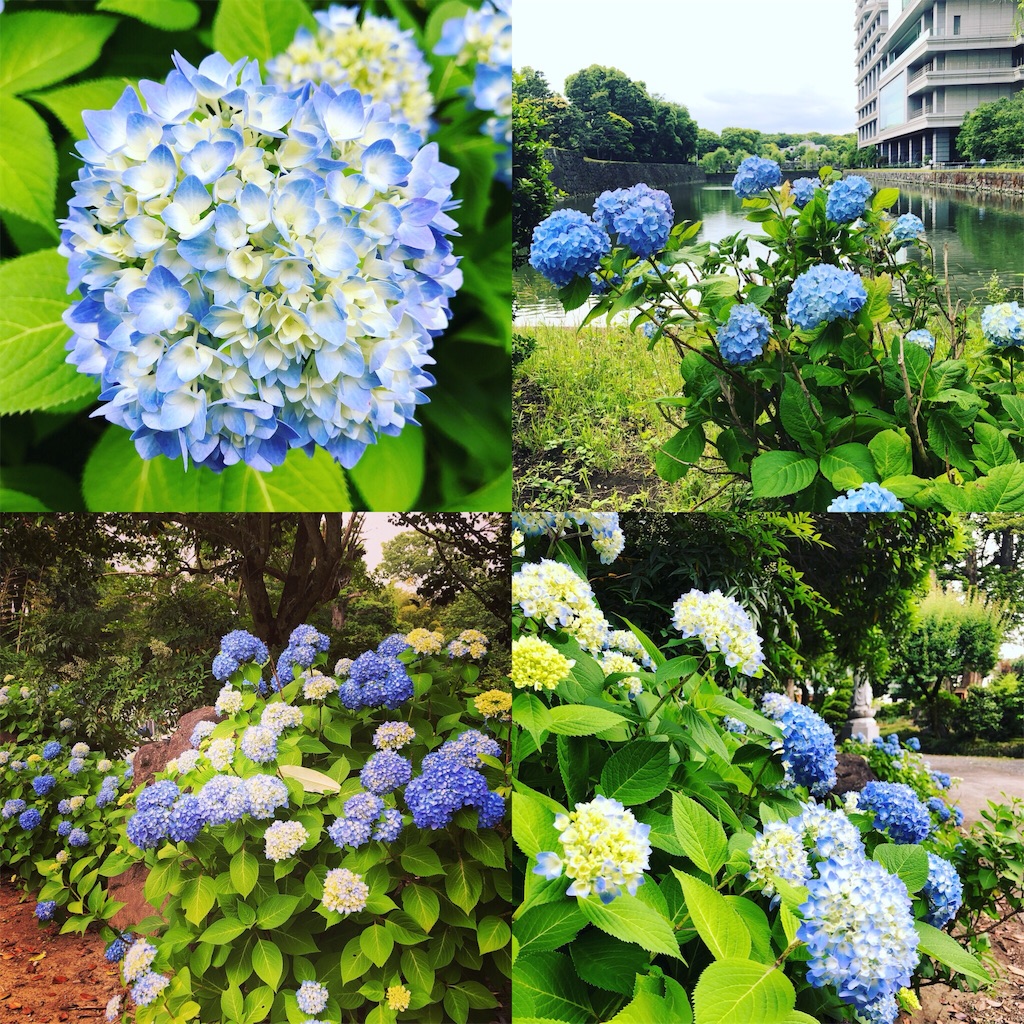
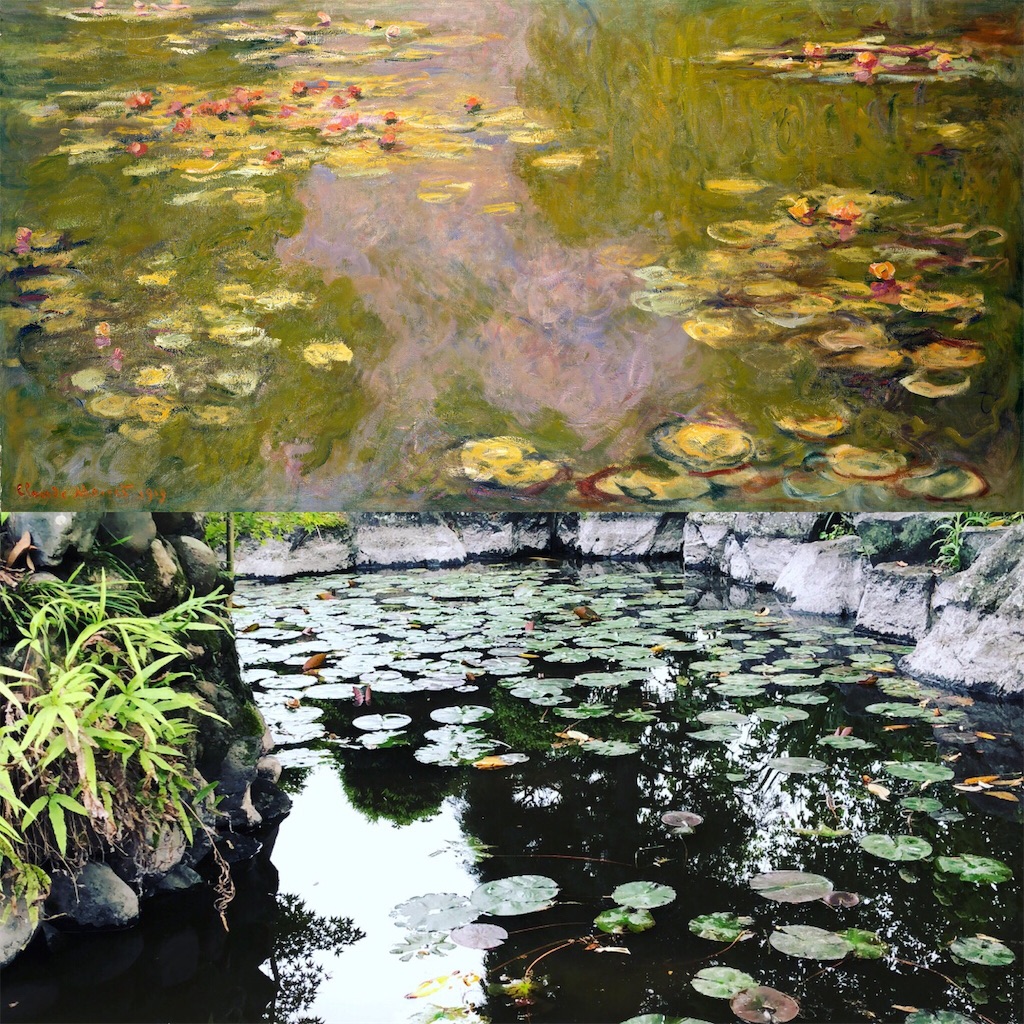

ローグワンに窺える戦国武将 Samurai Traces in Rogue One

「フォースの覚醒」が公開された2015年はある意味で「スターウォーズの年」でもあって、世界中にそのワクワク感が繰り広げられました。この日本でも多岐に渡るスターウォーズ関連の企画が展開され、その一つは日刊スポーツが手掛けた「スターウォーズ新聞」でした。日本の独特のスポーツ新聞の形式を用いて、新作に関する情報を4号に渡って発信しました。2016年のローグワンの公開の前に日刊がその新聞を復刊して、数多くの興味深い記事も掲載しました。その記事の中で特に目に留まったのはローグワンのキャラクターを戦国武将に例えるものでした。完全に一致しないものもありますが、意外にも納得できる類似点が多いです。
The world was seized by a wave of excitement ahead of the release of The Force Awakens in 2015. In a certain respect, 2015 was “the Star Wars year.” Here in Japan, there were a number of Star Wars-related events and programs, one of which was the Star Wars Newspaper put out by the Japanese sports newspaper company Nikkan Sports. Four issues of the paper were released that year, with each issue introducing information about the new film through Japan’s own unique format for sports news periodicals. Nikkan Sports brought the paper back for a special issue in 2016 ahead of the release of Rogue One, and it featured a number of interesting articles. One that really caught my attention was a piece that paired Rogue One characters with famous warriors/warlords from the Sengoku (Warring States) Period that shared similar personality traits. Although some of the comparisons are a little off, it is interesting to see how many similarities there actually are. Here is my translation of the article.
帝国軍
Galactic Empire

ダースベイダー:徳川家康
Darth Vader→Tokugawa Ieyasu
強大な帝国軍の司令官として銀河に名を轟かすシスの暗黒卿。並外れたフォースを持つ若きジェダイ騎士だったが、ダークサイドに落ち、皇帝の右腕になった。
Dark Sith Lord and Supreme Commander of the Grand Imperial Army known all throughout the Galaxy. Once a young Jedi Knight with exceptional Force abilities who fell to the Dark Side and became the Emperor's enforcer.
家康的ポイント=フォース
Ieyasu trait: The Force
信長、秀吉の下で力を蓄えた虎視耽々。天下統一までの「最強のNo. 2」的立ち位置は家康ベイダー共通。人の弱点を見抜き人心掌握。洞察力はまさに「フォース」。
Ieyasu was a great warlord who built up his power under Oda Nobunaga and Toyotomi Hideyoshi, waiting for his opportunity to seize control. The ultimate "No. 2" who ultimately unified Japan, Ieyasu's standing very much resembles that of Vader. His ability to see through people and identify their weaknesses resembles the perception one gains through the Force.

オーソンクレニック:本田正信
Orson Krennic→Honda Masanobu
デストルーパー部隊を率いる帝国軍の高階級将校。ダースベイダーの忠誠を装いながらも、陰で皇帝に取り入ろうと企んでいるらしい。
High ranking Imperial officer with his own squadron of Death Troopers. Feigns loyalty to Vader while attempting to scheme his way into the Emperor's graces.
正信的ポイント:嫌われ者
Masanobu trait: Loathed by all
家康の参謀として知略を尽くし県政をふるった。家康を裏切って敵対した過去があり仲間内から「腸(はらわた)の腐ったやつ」と嫌われた。嫌われ度はクレニック並みかも。
Staff officer to Ieyasu who used his intellect and wit to wield influence. Comrades who had once betrayed and fought against Ieyasu in the past claimed he was "rotten to the core." He may have been despised just as much as Krennic.
反乱軍
Rebel Alliance

ジンアーソ:真田幸村
Jyn Erso→ Sanada Yukimura
本作のヒロイン。有名な科学者の娘だが15歳の頃から1人で暮らす孤独なアウトロー。過去に犯した罪を帳消しにすべく、反乱軍に加入した。97.6%生還不可能なデススター設計図強奪計画に命を懸ける。
The heroine of this particular Star Wars tale. The daughter of a renowned scientist, she's a bit of an outlaw who has been on her own since the age of 15. Joins the Rebellion because she believes she needs to atone for her past sins. Ready to stake her life on a mission with only a 2.4% chance of success to steal the Death Star plans.
幸村的ポイント=強大な敵への超困難ミッション
Yukimura trait: Proclivity to tackle nearly impossible missions against imposing foes
九度山での孤独な幽閉生活から立ち上がり、大坂の陣で総数20万余徳川軍に挑んだ幸村。「何もかもなくしたゼロの状態→強大過ぎる敵に不可能に近い命掛懸けの戦い」という熱い運命がジンと重なる。「有名な父」という設定も似ている。
Yukimura began his life in solitary confinement on Mt. Kudo, and then went out with a bang in 1615 when he rose against Ieyasu and his grand army of 200,000 strong during the Osaka Castle summer campaign. Yukimura lost everything countless times in his life, yet always rose back up and gave his all to take on seemingly impossible odds. Jin's own life journey mirrors Yukimura's path and experience. Both of them also share the distinction of having a famous father.

キャシアンアンド―:直江兼続
Cassian Andor→Naoe Kanetsugu
ジンのお目付け役に任命され行動を共にし支える反乱軍の将校。実戦経験、情報戦ともに秀でるリーダー。自分でプログラミングしたK-2SOとは強い絆で結ばれている。
Rebel officer tasked with keeping an eye on Jyn and supporting their mission to find Galen. A true leader seasoned in combat and intelligence activities. Enjoys a tight bond with K-2SO, the Imperial droid he re-programmed.
兼続的ポイント=参謀
Kanetsugu trait: Strategist
上杉景勝を生涯にわたり支えた。外交を得意としあ資質も情報戦に秀でるキャシアンと重なる。石田光成と気脈を通じたと言われK-2SOとの関係に似ていなくもない。
Kanetsugu devoted his entire life to being the staunch rock for his lord Uesugi Kagekatsu. His outstanding acumen in diplomacy and counter-intelligence resemble those of Cassian. His rapport with Ishida Mitsunari also brings to mind the relationship Cassian shares with K-2SO.

K-2SO: 石田光成
K-2SO→Ishida Mitsunari
ジンたちに同行する警備ドロイド。帝国軍の監視ロボットだったかキャシアンが再プログラミング。瞬時に状況分析。自信家で独善的。C-3POと逆で人にかしずかない。
Security droid that accompanies Jyn and her "rogues" on their mission. Once a surveillance droid, he has been reprogrammed by Cassian to fight for the "good" guys. Able to analyze any situation nearly instantaneously, but a bit full of himself and self-righteous. The polar opposite to C-3PO, he doesn't wait on people.
光成的ポイント:分析力
Mitsunari trait: Analytical prowess
状況分析に優れた官僚として、秀吉政権を支えた光成。上にも下にも傲慢な態度をとったと言われ、人にかしずかない性格はK-2SOに似ているかも。
Mitsunari applied his superb ability to analyze any situation to support Toyotomi Hideyoshi's rule over Japan. Both his superiors and subordinates reportedly viewed him as haughty, and he was never one to wait on or cozy up to people. That seems to describe K-2SO to a "T".

ボーディールック:雑賀孫市
Bodhi Rook→Saika Magoichi
ある時は帝国軍の運び屋。ある時は反乱軍のエースパイロット。帝国軍のやり方に疑問を覚え反乱軍に加入。飛行技術は誰にも負けない。ひとたび操縦桿を握ればヒーローに。
Imperial cargo pilot one day, ace Rebel pilot the next. Decided to cast his lot with the Rebellion after doubting the methods and intentions of the Empire. Piloting abilities are second to none, transforming him into a hero the second he takes hold of the controls.
孫市的ポイント:芸
Magoichi trait: True specialist
無敵を誇った鉄砲隊を束ねる。報酬次第でどんな大名にも雇われるフットワーク。鉄砲という「一芸」を武器に信長を苦しめ、権力に屈しなかった。ボーディーと重なる。
Magoichi led a band of nearly invincible musketeers, willing to ply their trade for whichever warlord was willing to pay them the right price. A persistent thorn in Nobunaga's side with their deadly skill behind the trigger, never surrendering to any form of authority. Bodhi's character brings to mind these characteristics.

チアルートイムウェ:加藤清正
Chirrut Imwe→Kato Kiyomasa
ジェダイがほろんでしまった時代に、フォースの力を信じるスピリチュアルな盲目の僧侶。強じんな精神力で棒術の達人になった。明友ベイズと常に一緒にいる。
Fervent blind monk who continues to believe in the Force despite living in a post-Jedi galaxy. Drew upon his incredible spiritual power to become a master wielder of the bow staff. Always travels together with this trusted friend and ally Baze.
清正的ポイント=達人
Kiyomasa trait: Master warrior
秀吉豊臣下最強の武将。「七本槍」「虎退治 (文禄、慶長の役)」などで知られる槍の達人。築城の達人としても知られる。熱心な法華経信者でスピリチュアルなところもチアルートと共通する。
Kiyomasa was one of the most accomplished warriors to serve under Toyotomi Hideyoshi. One of the renowned "seven spearmen" and fierce tiger slayer (during the invasions of Korea in the 1590s). In addition to his skills in combat, he was also an expert castle architect. His fervent devotion and practice of the Lotus Sutra (Buddhism) reveals a devout spiritualism much akin to Chirrut's own faith in the Force.
注釈:初めてチアルートが一心に唱える「フォースは我と共にあり、我はフォースと共にある」と聞いたとき、すぐに思い浮かんだのは戦国時代の戦場で敵に襲い掛かるときにある仏教宗派の宗徒が唱えた念仏のことでした。それは浄土真宗から派生した一向宗という宗派であり、その宗派の総本山は現在の大阪府にあった本願寺でした。「南無阿弥陀仏」と唱え、仏に身を任せれば、戦死しても極楽土へと成仏すると信じていました。その念仏を意訳すると「南無阿弥陀は我の救済」という意味になります。この念仏の唱えはあまりにも滑らかであることから、繰り返して唱えると集中力を高めると同時に不安を一蹴する効果もあるという説もあります。その意味でこの南無阿弥陀仏の念仏はチアルートが唱える「フォースの祈り」と見事に連想するとも言えます。「南無阿弥陀から見ると皆は平等であり(無階級)」という宗教思想を布教する一向宗は、織田信長を始め当時の戦国大名がこの教団を強大を脅威と見ていました。
**Footnote: Chirrut's chanting of "I am one with the Force, and the Force is with me" instantly reminded me of a Buddhist chant from one sect that was commonly chanted by followers as they went into battle during this period. They were an offshoot of the Josdo-shin (True Pure Land) Buddhism, and their head temple was at Honganji (in present day Osaka). They believed that chanting "Namu Amida Butsu" would enable them to enter paradise should they perish in battle. One way to interpret this chant is "I take refuge in Amida Buddha". Some claim that the smooth manner in which the chant rolls off the tongue helps to remove anxiety and focus your concentration, so in that respect it is fitting that Chirrut mutters his own chant when entering the fray. Incidentally, rulers such as Nobunaga viewed this sect as extremely dangerous because they proclaimed all people were equal in the eyes of Amida Butsu (Amidtha Buddha), or literally "none above, none below".

ベイズマルバス:福島正則
Baze Malbus→Fukushima Masanori
相模で親友のチアルートのためなら命を惜しまない重装備兵士。後先を顧みない無鉄砲な性格。チアルートと対照的にスピリチュアルな力より巨大ブラスターを信じる。
Heavy weapons expert willing to lay down his life for his friend and sidekick Chirrut. A reckless character who doesn't think twice about the consequences of his actions. Not the spiritualist Chirrut is, he places his faith in the massive blaster he wields to deadly effect.
正則的ポイント=盟友
Masanori trait: Devoted ally
秀吉の小姓時代から加藤清正と仲が良く共に「賤ケ岳(しずがたけ)の七本槍」に数えられた。ベイズとチアルートの盟友関係と重なる。「無鉄砲な乱暴者」な逸話多数。これもベイズ的。
Masanori was another one of the "seven spearmen" under Hideyoshi at the Battle of Shizugatake against Tokugawa Ieyasu. He was close friends with Kato Kiyomasa, and both of them served Hideyoshi from a young age, displaying a strong bond that Baze and Chirrut mirror in the film. A reckless man that loved a fight, much like Baze in Rogue One.

ソウゲレラ:後藤又兵衛
Saw Gerrera→Goto Matabei
帝国軍の圧政の中でパルチザンを率いて権力に対抗する。その戦いぶりは過激で向こう見ず。あまりに苛烈なため見方からも恐れられる。
A leader of a partisan group that fights back against the oppressive rule and authority of the Empire. A rather extreme fighter that is sometimes more reckless than he is brave. His proclivity to go to the edge has made him feared even among allies.
又兵衛的ポイント=苛烈
Matabei trait: Hard core
戦国時代きっての猛将。大坂の陣で劣勢の豊臣方につき牢人達を率いて徳川勢に対抗。大軍勢に囲まれ壮絶に打ち死に。反権力と苛烈さがソウゲレラを想起。
Fierce warrior that lived through the thick of the Sengoku Period. Cast his lot with the outnumbered Toyotomi forces in the Osaka campaigns (1614-1615) and led a band of ronin (masterless samurai) against the Tokugawa army. Met a heroic death surrounded by enemy forces. His hard-core, borderline extreme resistance to authority conjures up images of Saw Gerrera.
日本の中空構造 Japan’s Functional Emptiness
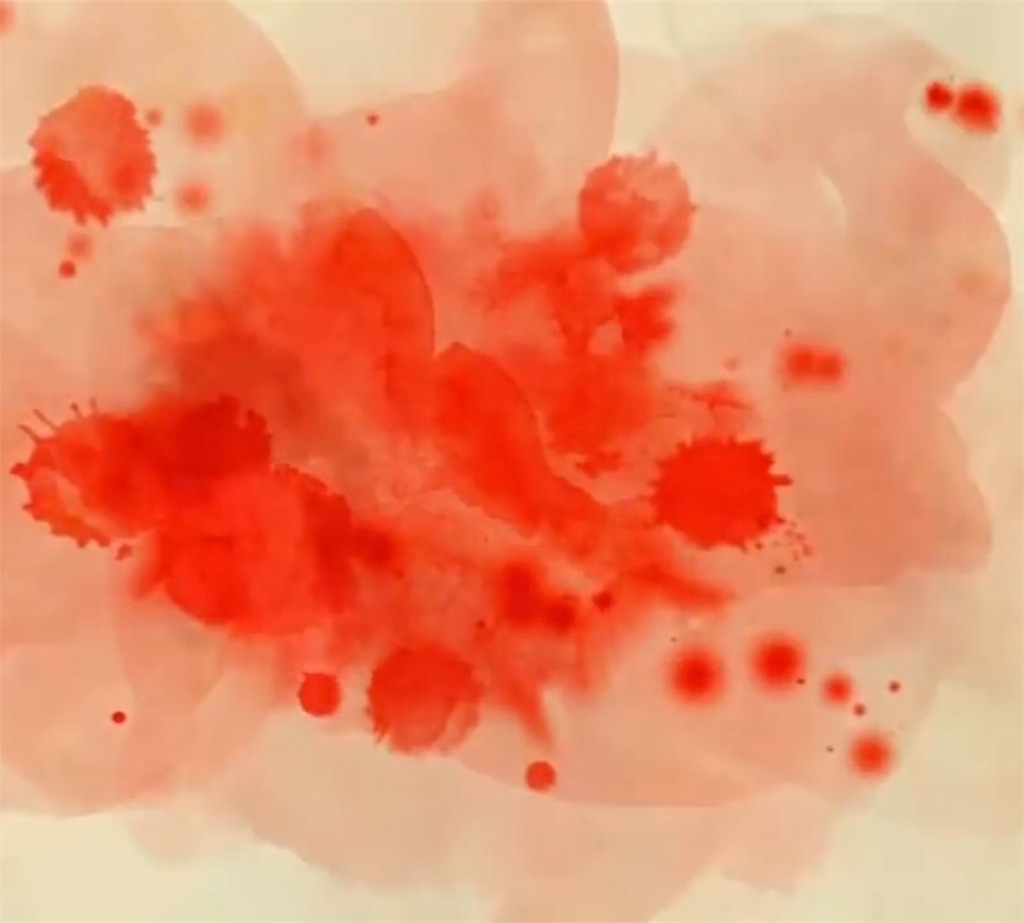
日本のテレビの気に入り番組を挙げようと言われますと、まず思い浮かぶのはNHKで放送される「100分で名著」です。「旧約聖書」から「般若心経」まで、多岐に渡る名著を取り上げて、四回(一回ずつは25分)に渡ってその名著のテーマと文化的な価値を考察する構造となっている番組です。ちょうど三年前の正月にこの番組のスペシャルバージョンである「100分de日本人論」が放送されて、非常に興味深い座談会となりました。この座談会に参加したのは現代日本を代表する下記の4人の論客:
If I was asked to name a particular Japanese TV program that I enjoy, the first one that comes to mind is “Master Works in 100 Minutes” on NHK. The show takes famous pieces of literature, ranging from works as diverse as the Old Testament and the Heart Sutra, and then examines their cultural importance over the course of four 25 minute episodes. Three years ago NHK aired a special edition of this program during the New Year’s Holiday. Dubbed “Japanese Theory in 100 Minutes”, this fascinating panel discussion brought together four of Japan’s leading scholars today:
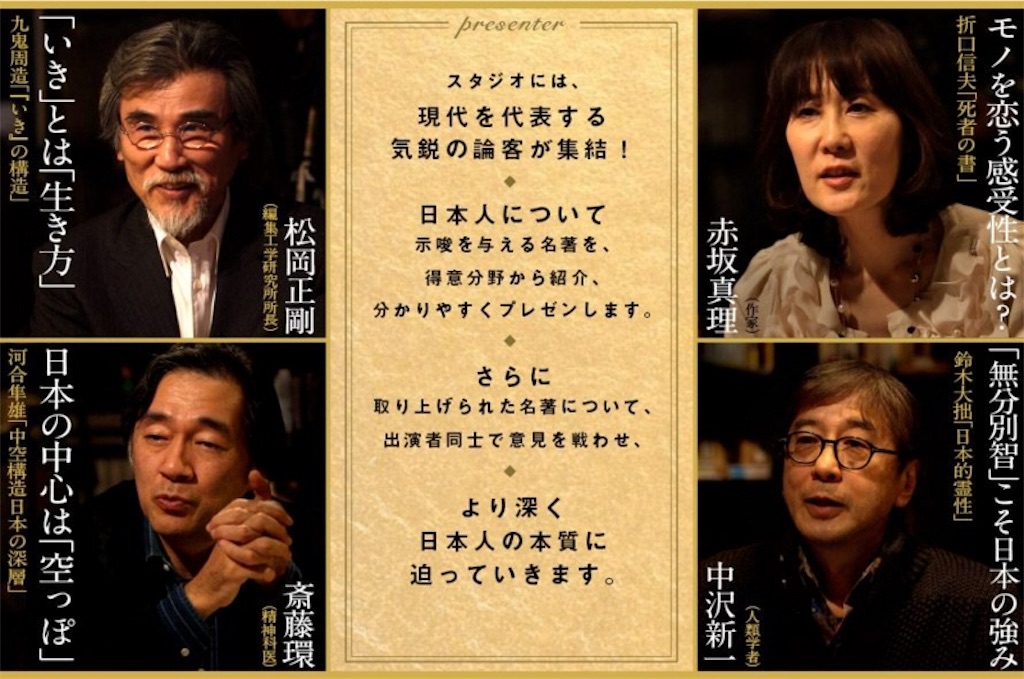
Source: NHK
松岡正剛(編集工学研究所所長)
赤坂真理(作家)
中沢新一(人類学者)
Seigo Matsuoka (Head of Editorial Engineering Laboratory)
Tamaki Saito (Psychologist)
Mari Akasaka (Novelist)
Shinichi Nakasawa (Anthropologist)
この四人が日本人の本質をよく表していると考える一冊を紹介し、分かりやすく解説するという特別企画でした。あまりにも深い話でもありましたので、座談会の内容をそのまま書き起こした出版物にもされました(購入済み)。
Each member of this panel discussion was asked to introduce and provide a straightforward explanation of one work they felt conveyed a unique Japanese quality. The conversation was incredibly deep, so much so that NHK decided to publish a volume that compiled everything the panelists said over the course of the discussion (a book which I have bought).
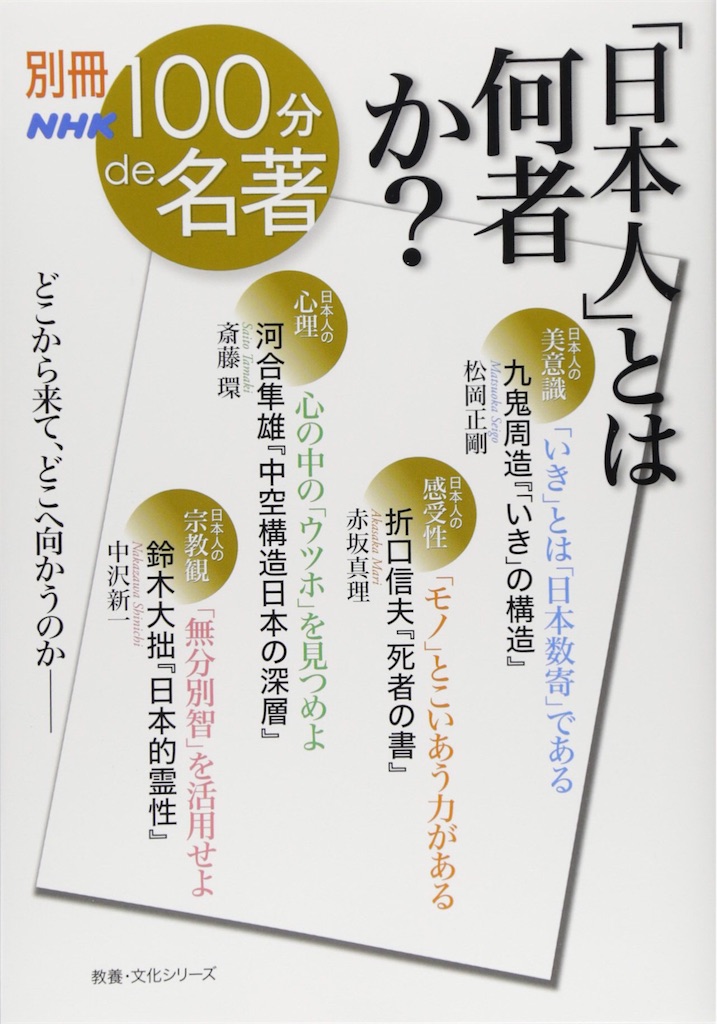
Getting to the Core of Being Japanese
このブログではこの座談会で紹介された本を一つずつ取り上げたいですが、まずこの投稿で考察するのは斎藤環が選んで紹介した河合隼雄(かわいはやお)の「中空構造日本の深層」の単著です。この本は「日本文化の中心は、空っぽなのだ」という長年の研究において河合氏が辿り着いた独特な持論が展開されます。
I’d love to examine each of the books discussed by this panel, but for the sake of this post I will take a look at the book introduced by Tamaki Saito: Getting to the Heart of Japan’s Empty Framework by Hayao Kawai. This book lays out the original theory that Kawai arrived at after many years of research. He argues that the core of Japanese culture is in essence “empty space”.
日本の神話には、正体不明の謎の神様というのが、必ず出てくると共通点に河合氏が注目を当てました。「それぞれの三神は日本神話体系のなかで画期的な時点に出現しており、その中心に無為の神を持つという、一貫した構造をもっていることがわかる。これは筆者(河合)が “古事記”神話における中空性と呼び、日本の神話の構造の最も基本的事実であると考えるのである。」
One common feature present throughout Japanese mythology that Kawai zooms in on is the presence of an obscure divinity. “In Japanese myths, we always see three divinities appear at key moments within the narrative. The central figure of these trinities is always an idle divinity that does nothing. I (Kawai) refer to this as the “emptiness” of the Kojiki lore, and it represents the most fundamental truth within all Japanese legends.”
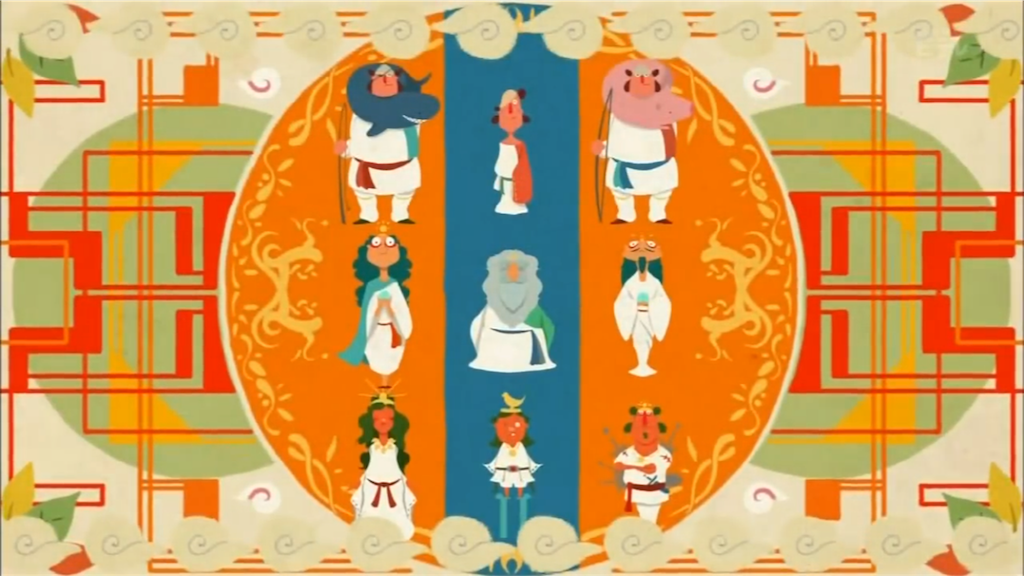
Source: NHK
河合氏が取り上げる典型の例は古事記の冒頭に登場する三人の神:アメノミナカヌシ (天之御中主)、ツクヨミ (月読)、とホスセリ (火須勢理)。アメノミナカヌシとホスセリ (火須勢理)はちゃんと有為な神として扱われている一方、ツクヨミは何もしないです。河合氏がこの神話の構造をこう説明します:「日本神話の中心は空であり、無である。このことはそれ以後発展してきた日本人の思想、宗教、社会構造のプロトタイプとなっていると考えられる。」
In his book, Kawai calls attention to three divinities that appear at the beginning of The Kojiki (Records of Ancient Matters): Amenominakanushi, Tsukuyomi, and Hoseseri. While Amenominakanushi and Hoseseri are depicted as active players in the narrative, Tsukuyomi does absolutely nothing. Kawai explains this mythological structure as follows: “The very core of Japanese myths is empty, indeed nothingness. This structure provided the prototype for the underlying make-up of all Japanese thought, religion, and society that have developed from that point (ancient times) forward.”

Source: NHK
この点について座談会の話が弾み出します。まず松岡氏が注目するのは「中心は空(うつ)である」である点です。以前この松岡氏が唱える「現(ウツツ)」が派生させる「移ろい」というコンセプトを考察する記事を書いたこともありますが、ここで松岡氏が同様のコンセプトが河合の唱える中空構造の仮説に置いて働いていると下記の通り解説します(「日本人とは何者か?」より引用)。
This point really gets the discussion moving. Matsuoka’s draws attention to the “empty core” concept and states how the “空 (kuu, void or sky)” character in the word “中空 (chuukuu)” can also be read as “utsu.” This reading is derived from that of the character “現 (utsutsu, the now)”, which in turn gives rise to the idea of “移ろい (utsuroi, change or transition)”. I have explored this idea in a previous post, so check it out if you would like to learn more. As shown below, Matsuoka argues that this same concept is at work within Kawai’s “empty core” hypothesis (quote from Getting to the Core of Being Japanese).
“中心に「ウツなるもの」を置き、それがあることによって両脇の二つが動いているという河合の仮説には納得のいくものがあります。一見空っぽだが、いざとなるとそこに何かが湧き出てきたり、力が潜んでいたりする。信号に青と赤のほかに黄色があるように、A/非Aという二尺せず、真ん中に三つ目を置くことによって、どちらも生かすのです。日本人は中空構造に無意識であるかゆえなのか、方法的なことをかなり特別に意識し、大切にしていると思います。そうしないと中空に異質なものが入ってきたときに、大変な事態になりかねない。”
“I believe there is some weight behind Kawai’s proposition of a three-part structure centered on something empty, but with that void putting the two sides into motion. At a glance it appears there is nothing but emptiness, but out of necessity this void can give rise to something, or transform into this well of latent power. A stoplight has not just red and green, but also yellow. It’s more than just A or not A; putting something in the middle allows us to keep both. Japanese people pay special attention to the processes behind things, perhaps because of this functional emptiness at work within their subconscious, and really cherish them. They have to clue in on these processes, for failure to do so can cause things to fall apart when something alien enters that void.”
中沢氏が松岡氏のいうこの中間の特徴が日本の社会や自然に対する価値観においてどのように機能しているか、そしてどのような危険性が潜んでいるのかを下記の通りの解説を付け加えます(「日本人とは何者か?」より引用)。
Nakazawa further elaborates on this idea of putting something in the middle that Matsuoka described. In the following excerpt, he shows how this idea works within Japanese society and its view on nature, as well as the potential danger it entails (quote from Getting to the Core of Being Japanese).
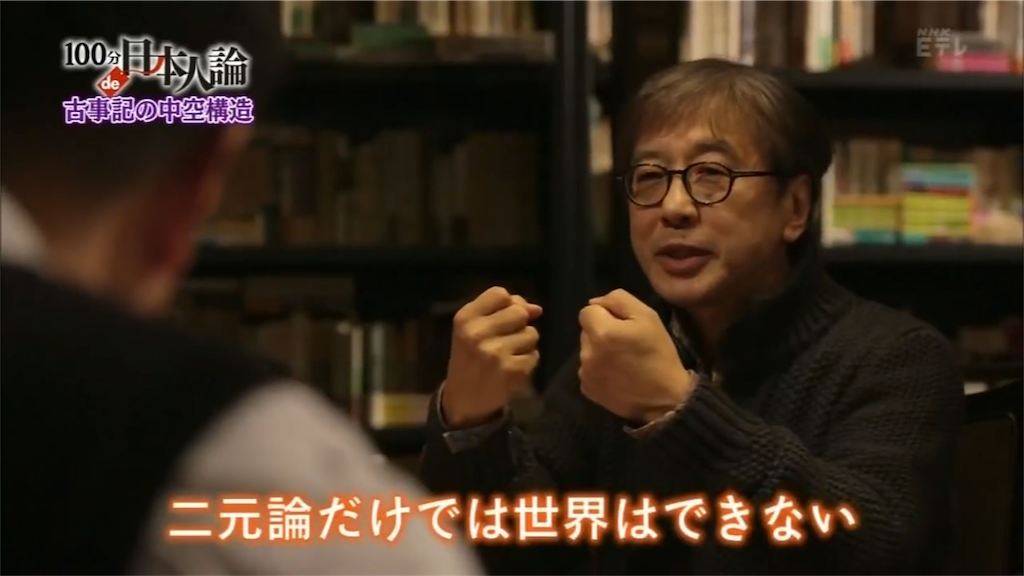
Source: NHK
“宇宙を作るには三項が必要だが、三項目は潜在的で表へ出ない。日本の神話において、天と地、海と山という二元論の起源はバーチャルで、このバーチャルに一項が与えられている、というのが河合さんの基本的な直観なのではないでしょうか。人間は、自然な状態だとこの思考方法が一番合理的で、例えば中空領域を置くことで、お互い妥協を図ることができます。自分と違うものを排除するのではなく、相手の原理を自分の中に入れることが可能になってくる。”
“You need three elements to form the cosmos, but the third is this latent force that never comes to the forefront. In my view, Kawai’s basic hunch is that an extra element is added to the virtual base underlying the dualistic facets of Japanese legends, such as the pairings of earth and sky or sea and mountain. This is the most logical mode of thought for human beings in our most natural element. In allotting this empty space, we create an area where we can work things out and reach a compromise with one another. Rather than simply eliminating what is different from you, it becomes possible to take the tenets of the “other” and make them a part of your being.”
“その例として典型的なのが、日本の風景は、中間領域を残しておくことが基本になっています。人間と、山の生き物。二つが重なり合うところに里山を作る。里山は中間領域ですから、人間にとっても、昆虫や魚、動物にとっても素晴らしい住処(すみか)にも成り得る。生き物の要求する生存条件を認めているわけです。計算や計画といった合理性で出来上がった世界には、中間がありません。ところが日本人の社会は中間性というものをベースにできていますので、その点は人類の期待、希望の星でもあります。しかしそのことに無自覚のままだと、70前の戦争と同じような状況に突入してしまう可能性もあるという、両刃(もろは)の剣でもあるのです。”
“Japanese landscapes provide us with great examples of this principle at work, for they are based on the idea of leaving some form of middle ground. This is the satoyama (里sato for “village” and 山yama for “mountain”) concept, or the idea of a place where human beings and life on the mountain come together. A satoyama holds the potential to be a truly wonderful place for all life—human beings, insects, fish, and animals—precisely because it is a middle ground. It’s an acknowledgement of all the conditions for subsistence that living things seek. On the other hand, there is no middle ground in a world rooted in the rationality of calculation and planning. In a certain respect, Japanese society stands as a beacon of hope for people of all humanity because it is based on this idea of allowing for room in the middle. That said, this very characteristic is a two-edged sword. If we are completely oblivious to this, we could fall headlong into the same set of circumstances as that war 70 years ago.”
そこから赤坂氏がその三項構造の考察を下記の通り続きます。中沢氏と同のようにこの三項構造は人間にとって一番自然な思考法と主張しつつ、過去に日本人がその構造に無自覚になるとどの悲惨を招いてしまうかを指摘します(「日本人とは何者か?」より引用)。
Akasaka continues this examination of the three-part structure at work. Just like Nakazawa, she believes this is the most natural mode of thought for human beings. At the same time, she also draws attention to Japan’s past and the tragic consequences of becoming oblivious to this structure (quote from Getting to the Core of Being Japanese).

Source: NHK
“日本人は「神」がわからない、世界で例外的な民族である」などというふうに、日本人自身の間でも、言われます。が、私は、この場合に「神」と言われている一神教の神という概念(そして善悪二元構造)は、危機の時代の思考の飛躍から生まれたものであって、人間の自然状態では「三項構造」を出してくるのではないかと思っています。この点は、中沢新一先生に確認しましたが、そうだということでした。”
“There are those who say—including some Japanese people—the fact we don’t understand “God” makes us one of the world’s unusual races. The God I’m referring to in this instance is of the monotheistic religious tradition based on a dualistic structure of good and evil. I’ve always held that this form of religion bursts forth from the intellectual currents of ages of crisis, and that the natural mode of thought for human beings is more aligned with a three part structure. Indeed, Professor Nakazawa has reaffirmed that is the case.”
“日本人が近現代まで、三項構造でやってこられたのなら、それは幸せなことだとも言えると思います。その三項構造の思考パターンを無意識に下敷きにして、天皇を神であり中心とした国を、明治(時代)に作りました。それはまさに天皇を「責任があって、責任がない立場」、つまり「三項構造の真ん中」のように中空構造につくるやり方でした。それは良い悪いではなく、ただの「構造」です。けれど、ただの構造であるからこそ、それが「利用」されるとき、誰にも止められず、誰の責任も問えない悲惨が発生します。それは入力したものが自動的に達成されるブラックボックスのようです。そして、そのことがうまく説明できなかったために、日本人は戦後、戦争のことについて口をつぐむことになりました。そして語れないひずみも、現在進行形でたまる一方です。あれほどの失敗は、まさに構造から来ていたと思います。そして、構造を用いるのにあまりに無自覚であったことから、来ていたと思います。その意味で思想的な「危機の時代」は、今も続いています。”
“Perhaps this three-part structure is what enabled Japanese people to endure into modernity. In that regard, I guess we could say we were blessed. In the Meiji era (1868-1912), Japan created a nation state with the Emperor as the divine head in the center, a system unwittingly based on that very three-part structure mode of thought. This approach led to the creation of a system that placed the Emperor in a position of “both responsibility and no responsibility.” It was a reflection of this empty core concept. This is not a question of good or bad; in the end it is just a system. However, when this system is “used,” it can court disasters that no one can stop or take the blame for. It’s like this black box that automatically carries out whatever is put inside it. Japanese people were unable to effectively explain the nature of this system after the war, and this failure has caused us to remain silent on the issue. The strain wrought by this silence continues to pile up today. I believe the system is root of that grave mistake of the past. Indeed, the fact we were so oblivious to this system being used is what led to that mistake. In that sense, we still find ourselves in an intellectual ‘age of crisis’.”
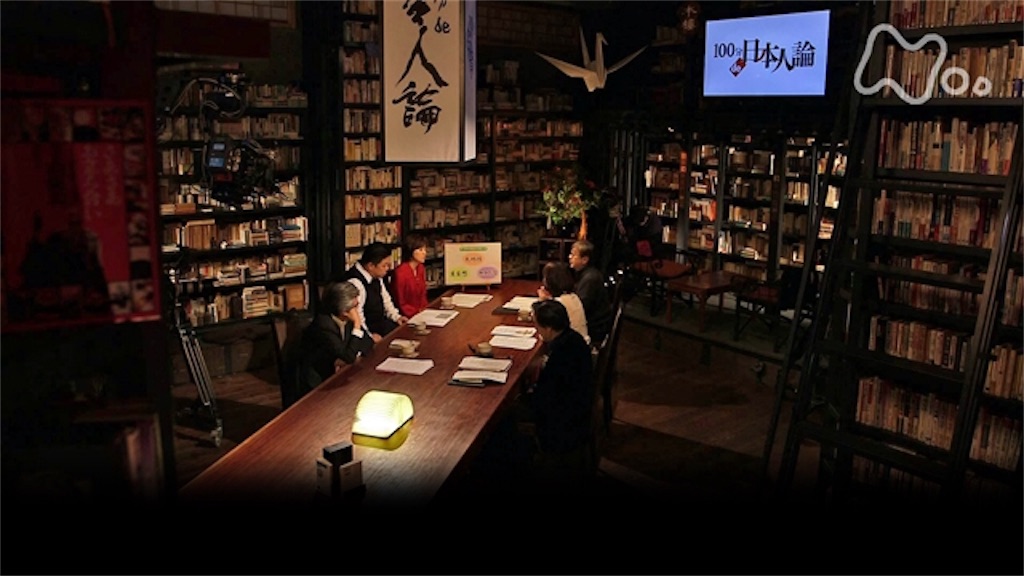
Source: NHK
上記の三人が話したように、河合氏が唱える中空構造は柔軟性に長けた思考方法でありながら、一長一短もあり、それを自覚して上手くコントロールする必要があると斎藤氏が論じます。一方、外来のものというレッテルを張ったまま共存していくという長所があります。漢字はまさにその象徴です。「漢の字」が示すように、中国の字でもありながら、日本語に当てはまって1500年以上に使い続けられています。また、中空構造によって日本文化的なものを並行して温存されていくメリットもあります。かつての神仏習合はその典型的な例でしょう。朝鮮半島を通して日本に入ってきた大陸の宗教である仏教が道を排除することなく、妙な形で習合し、それぞれの宗教が欠ける点を補い合う日本の風土に適した独特な宗教の構造を醸し出しました。
Just as these three scholars explained, the empty-core structure described by Kawai is an incredible flexible method of thought. However, it is not without its faults. Saito argues that the important thing is to recognize both its merits and faults, and work to effectively manage them. One advantage of this system is that it incorporates elements from the outside, finds a way to make them coexist, yet also retain a vestige of their roots. We see this exemplified by the use of kanji in Japan. The very characters used to form the word 漢字 (kanji) make it clear where their roots lie. 漢 represents kan or han, which implies Chinese, and 字 for ji indicates written characters. While they were adapted to Japanese language and have been in use for over 1500 years, they’ve never lost that foreign label. Another merit of the empty-core structure is that it finds a way to preserve Japanese elements alongside those that enter from the outside. A classic example of this is 神仏習合 (shinbutsu-shuugo), or the fusion of Buddhism and Shinto. Buddhism entered Japan via the Korean peninsula. Instead of eliminating Shinto, Japan found a singular way to meld this continental religion with its own native beliefs, cultivating a unique system in which each religion made up for what the other lacked.
他方では、中空構造に潜む危険性に対して河合氏が警鐘を鳴らしたと斎藤氏が言います。その中心が空であることは、一面極めて不安であり、何かを中心に置きたくなるのも人間の心理傾向であると言えます。上記の赤坂氏の話でその傾向が招いた悲惨も触れました。河合氏も次の警告を残しました。「今度中心への侵入を許した場合、日本の中空構造はもはや機能しないのではないか。」河合氏の言葉を念頭に、日本人は全存在をかけた生き方から生み出されてきたものを、明確に把握してゆこうとしなければならいのはこの四人が至った結論です。これからの日本はこの教訓をどのように活かせるのかを拙僧も見守っていきたいと思います。
On the other hand, Saito shows how Kawai also warned of the danger inherent in this empty-core structure. The fact that there is nothing in the middle gives rise to a highly unstable quality. When faced with such instability, Kawai claims that human nature makes us want to put something in this middle ground. As we saw earlier, Akasaka touched upon the grave outcome of this tendency. Kawai leaves the following warning in his book: “The next time we let something encroach upon this middle space, Japan’s empty-core may very well cease to function.” With these words in mind, the four scholars concluded that the key is for all Japanese people to maintain a clear awareness of this structure, born of the living modus created over their entire existence. As we head into the future, I intend to see how Japan applies this lesson.
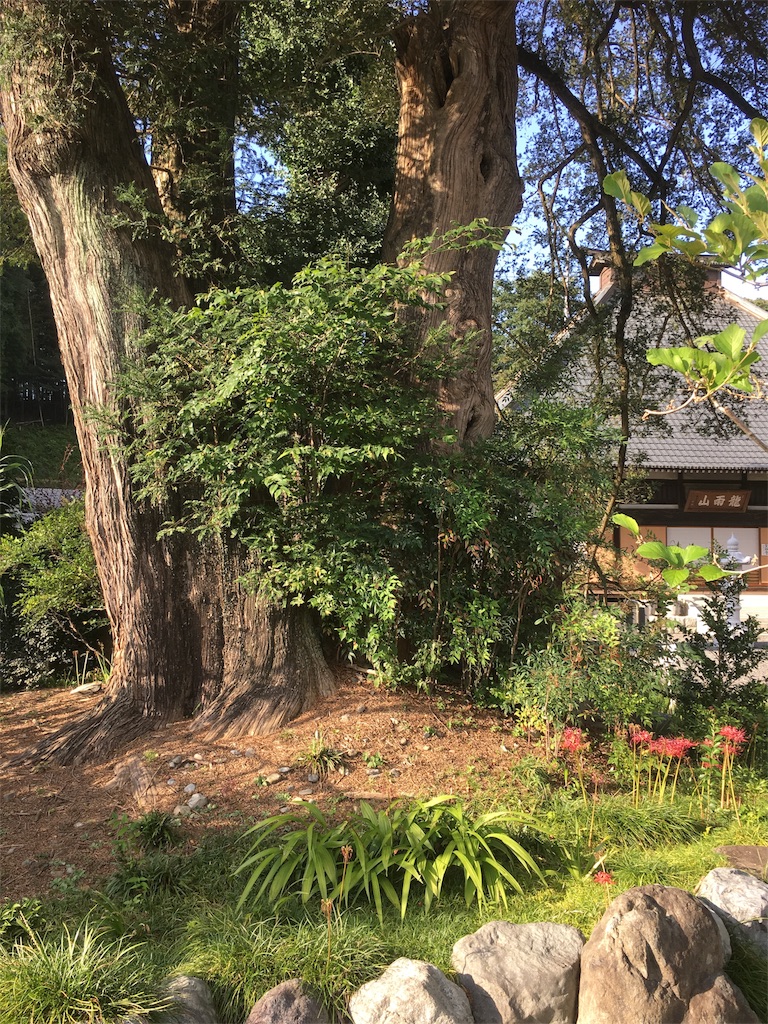
筆者の撮影
Author photo
喜捨(きしゃ)The Joy of Letting Go

スターウォーズエピソード4: 新たななる希望を始めて見たのはいつごろだったのかはっきり覚えていませんが、その映画が拙僧に焼き付けた印象は一生に渡って鮮明に映え続けています。印象的なシーンはあまりにも多いですが、その中で特に思いを寄せるのはルークにとって初めてフォースと触れ合ってその力を呼び寄せるシーンです。曹洞宗の僧侶である枡野俊明が著した「スターウォーズ 禅の教え」の前書きにはこのシーンを取り上げて、そこに窺える禅の教えを下記の通り解説します。
I don’t quite remember how old I was when I first saw Star Wars Episode 4: A New Hope. However, the indelible impression it left has remained vividly etched within my mind throughout my entire life. There are a number of memorable scenes in the movie, but one that I am particularly fond of is the scene in which Luke has his first experience with the Force and calls upon its power. The Buddhist priest Masuno Shunmyou (Soto sect of Zen) highlights this scene in the preface to his book Zen Wisdom from Star Wars, and provides the following discussion on the elements of Zen teaching it exhibits.
「一隻眼」を備える~智慧を持ち、一切の事物の本質を見る~
Unfettered eyes: The wisdom to see all things for what they are
禅の教えを読み解いた「スターウォーズ」エピソードIV、V、VIの中には、印象的なシーンがいくつもありました。中でもルークがオビ=ワンから初めてフォースの手ほどきを受ける場面は、「禅」と共通することが特徴的に現れています。ミレニアムファルコンの中でライトセーバーを使って修行を受けるルーク。そんなルークにオビ=ワンは、目隠し付きのヘルメットを渡し、「目は君を惑わすんだ。視覚を信じてはならん。」と、完全に視界を奪ってライトセーバーを使うよう教えます。これを見て私は「一隻眼」という禅語が思い浮かべました。
A number of scenes in the original Star Wars trilogy struck me in how they reflect Zen teachings. One that really left a deep impression on me was when Obi Wan gives Luke his first lesson in the ways of the Force. Watching that scene unfold, I felt that much of what Obi Wan says resonates with Zen concepts as we see Luke learn how to wield a lightsaber on the Millennium Falcon. Obi Wan hands him the helmet with the blast shield, effectively covering his eyes, and tells him “Your eyes can deceive you. Don’t trust them.” When I first saw this scene, the Zen word Isseki Gan (一隻眼) popped into my head.

Source: 田川悟郎書道 (Goro Tagawa Calligraphy)
仏教では、肉眼(通常の目)、天眼(未来を予知する目)、慧眼(一切の真理を見極める眼)、法眼(大宇宙の怒りに沿って真実を照らす眼)、仏眼(仏心で融通無碍に真実を照らす眼)の五つの真実を見抜く眼があるとしています。そして、「一隻眼」はこのすべてを兼ね備えており、智慧をもって一切の物事を見える特殊な能力のある眼(略)。オビ=ワンは、ルークに「一隻眼」を備えた人物になってほしいと願い、肉眼に惑わされないようにヘルメットをかぶせたのでしょう。ルークが「一隻眼」を備えた人物になり得たかどうか、「スターウォーズ」をご覧になっている皆さんにはお分かりのことだと思います。(以上)
Buddhism holds that there are five sets of eyes used to perceive the truths in Buddhism. First is the naked eyes (肉眼, niku-gen), which are used to see the world around us. Next we have the heavenly eyes (天眼, ten-gen). These eyes are for predicting what is to come. The third set is the wisdom eyes (慧眼, e-gen), which enable us to ascertain all forms of truth. The fourth is the dharma set of eyes (法眼, ho-gen). They shed light on the truth rooted in the reason underlying the macrocosms. Finally we have the Buddha eyes, which signify a merciful heart unhindered that illuminates the truth. That said, there is one set of eyes that encompasses these all. The Japanese word is一隻眼 (isseki-gan), and it describes possessing unfettered eyes with the special power to see all things by applying the wisdom we possess. I believe that Obi Wan was steering Luke in this direction, hoping that he would become a person endowed with unfettered eyes truly capable of seeing things (i.e. the Force) for what they really are. Thus, he covered Luke’s eyes with blast shield to ensure his sight would not cloud his view of the Force. For those of us who have seen the entire saga, we know how Luke ultimately did with this lesson. (End of quote)

さて、エピソード6が終わった時点でルークは本当に一隻眼が備えていたのでしょうか?最後のジェダイの展開を念頭に考えますと、その答えは「いや、まだ」と拙僧が思います。それはなぜかと言いますと、枡野僧侶が取り上げる上記のシーンに潜めているオビ=ワンの意図がヒントを与えます。では、上記の枡野僧侶の話の延長で仏教の基礎の知恵が網羅していると言われる般若心経のフィルターを加えて考察したいと思います。
Had Luke truly learned to look at the world (galaxy) with unfettered eyes by the end of Episode 6? Personally, I do not feel he had quite reached that point, given what we see unfold in The Last Jedi. I believe Obi-Wan’s intent within the scene that Masuno highlights above shows us why that is the case. Here I would like to expound upon the points Masuno raised by introducing an additional filter: the Heart Sutra, which is said to encompass all basic tenets of wisdom in Buddhism.

日テレの衝撃のスターウォーズ展 (From Nippon TV "Mind Blowing Star Wars Exhibit")
般若心経によりますと、私達が見るものは、経験に基づいて「心が決めているだけ」のものであり、そのもの実体はありません。私達は特定の概念を作り、その関連性の中で世界を見ています。この般若心経のフィルターを通して上記のシーンを改めて見ますと、オビ=ワンがルークに諭そうとしているのは概念に囚われずに世界(銀河)を見ることではないかと思います。ミレニアムファルコンの中でオビ=ワンの教訓を受けたルークが概念からの解放への第一歩を踏み出しました。だからこのシーンの最後にオビ=ワンがルークにこう言います:「より大きな世界(概念に狭まれず世界)に最初の一歩を踏み出したのだ」。
According to the Heart Sutra, all that we see is based on the definitions we create in our minds through our own experiences. These concepts have no actual substance. The relationships between the specified preconceptions we conjure form the framework by which we view the world. When we apply this Heart Sutra filter to the above scene, we see that Obi-Wan is trying to impress upon Luke the importance of viewing the world (galaxy) with eyes unclouded by preconceptions. Thanks to this lesson Obi-Wan imparts on the Millennium Falcon, Luke is able to take his first step towards freeing himself from preconceived notions. That’s why Obi-Wan says “You’ve taken your first step into a larger world (one unfettered by concepts)” at the end of this scene.

ただし、この大きな一歩を踏み出したものの、ルークは概念に囚われ続けます。まずはダゴバにてヨーダの下(もと)で修行を積むときのある失敗を経験します。フォースを使って沼に沈んだ己のX-Wingを浮かせて陸に移動するようにとヨーダに命じられ、やるのではなく「試みよう」とするルークは業が上手く運ばず、失敗に終わります。その失敗を招いたのはいうまでもなく概念でした。X-Wingのような大型の物体は機械を使わずフォースの力のみで浮かせて移動するのは無理(自分の経験から見て)と決めづけ、その結果自分に宿るフォースの力を阻む概念を作り上げてしまいました。ヨーダがフォースに信を置く手本を見せる目的はルークを諭すと同時に概念の無意味さを理解させるためでした。
However, even after taking his first major step into a larger world, Luke continues to cling to preconceptions. We see him encounter failure in his training with Yoda on Dagobah. Yoda tells him to use the Force to raise his sunken X-Wing from the swamp and move it to dry land. Luke “tries” instead of merely doing as he is told, and as a result he fails to complete the task handed to him. He convinces himself that that it is impossible (based on his own experience) to move a large object like an X-Wing using only the Force and not a machine. In short, he conjures up a preconception that inhibits the potential of the Force within him. In showing Luke what it means to put one’s trust in the Force, Yoda not only aims to admonish Luke, but also make him understand how pointless such preconceptions are.

伝説のジェダイ:ルークスカイウォーカー (Legendary Jedi: Luke Skywalker)
日テレの衝撃のスターウォーズ展 (From Nippon TV "Mind Blowing Star Wars Exhibit")
時を経た最後のジェダイのルークを見ると、この教訓はまだ完全に染み込んでいません。その逆に、新たに築き上げた概念に囚われています。それはダースベーダーの「伝説」とフォースの暗黒面の性質に対する概念です。ある意味で、その概念は師匠のヨーダが言い残したあの言葉から生み出されました:「一度暗黒の道にはまったら永遠に支配されてしまうぞ、お前の運命はな。」甥であるベンソロの中に繰り広げる闇を見たルークは、そこからのベンは永遠に暗黒面に支配され悪業と成してしまう運命(さだめ)が待っていると決めつけ、その「未来」を阻止するためベンを抹殺するしかないと考えました。自分自身が作り上げた概念が間違った行動を招いて、その結果ルークが阻止しようとした未来が現実となりました。
Luke still hasn’t fully learned this lesson by the time we see him in The Last Jedi. Rather, we find him held captive to a new concepts: his own preconceptions concerning the nature of the Dark Side of the Force and the legend of Darth Vader. In a certain respect, these ideas stemmed from the words that Yoda had uttered to him on Dagobah: “If once you start down the dark path, forever will it dominate your destiny.” When Luke saw the darkness spreading within his nephew Ben Solo, he assumed that it would forever dominate his path and destine him to commit horrific deeds. Thus, he decided the only way prevent this future from occurring was to murder him. This preconception that Luke built up within his mind led him to take the wrong course of action, which in turn ultimately brought about the very future he sought to avert.

最後のジェダイのアイマックスポスター (The Last Jedi Imax Poster)
その間違った行動に対する悔やみをあまりにも重く感じたルークは、フォースとの繋がりを遮断することにしました。そして、レイがアクトに来てフォースについて指導を求めても、彼女に宿る暗黒面を見てベンの二の舞が訪れるではないかと恐れたルークがジェダイの道に導くことを拒みました。レイが去る後にジェダイの遺産をぶっ壊すと決意したルークはちょうどそのときヨーダと再会します。そして、ヨーダと交わす会話で「概念は足枷であり、捨てるべし」と遂に理解します。枡野僧侶によりますと、禅に置いてこれは「喜捨」という表現が用いられています。「喜捨」はつまり「惜しむことなく喜んで捨てること」という意味です。喜捨の意味に悟ったルークはやっと「一隻眼」を取得し、オビ=ワンとヨーダが見せようとしたフォースの無限さを実感します。
The guilt of this mistake weighed so heavily on Luke that he decided to cut himself off from the Force. When Rey comes to Ahch-To in search of guidance in how to use the Force, Luke refuses to show her the ways of the Jedi because of the glimpses of darkness he sees within her. After Rey leaves, he decides to destroy the remnants of the Jedi order, and it is in this very moment he has reunion with Yoda. Speaking with his former master, Luke finally understands that preconceptions are nothing more than fetters that we must abandon. In his book on Zen and Star Wars, Priest Masuno describes this realization by using the Zen word “ki-sha (喜捨)”, which literally means “joyfully abandon regret”. When Luke accepts this notion of ki-sha, he obtains the unfettered eyes that allow him to experience the infinite potential of the Force that Obi Wan and Yoda attempted to show him.

喜捨。ヨーダがこの言葉の意味をよく分かっていました。だから最後に雷を落としてフォースの木を破壊します。「木(フォースの一面)を見て、森(フォースの全体)を見ず。」
Ki-sha (the joy of letting go). Yoda knew what that was all about. That’s why he summoned the lightning at the end to destroy the Force tree. You simply can’t see the forest (Force) for the trees (one aspect of the Force).